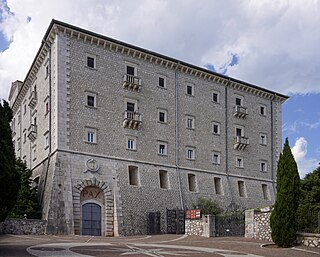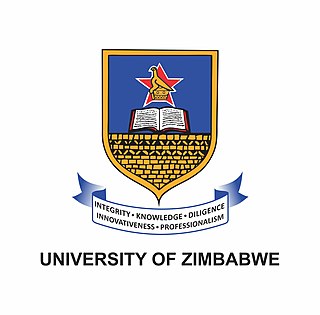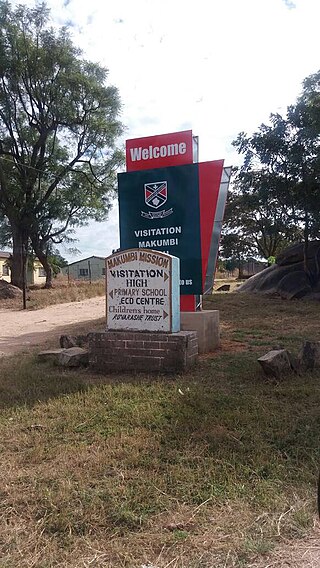This article includes a list of general references, but it lacks sufficient corresponding inline citations .(August 2018) |

Monte Cassino Girls High School is a Catholic boarding-school in the Mashonaland East province of Zimbabwe.
This article includes a list of general references, but it lacks sufficient corresponding inline citations .(August 2018) |

Monte Cassino Girls High School is a Catholic boarding-school in the Mashonaland East province of Zimbabwe.
The school was founded as part of the Catholic Mission at Monte Cassino in 1902, when Trappist monks selected a farm near the Macheke Siding and established the Monte Cassino Mission. It was built between two mountain ranges, with its entrance coming in from the west side after crossing the Mucheke River, 7 km south-east of Macheke.
A day and boarding school for boys was opened in 1908 and the following year, the monks formed the Missionary Order of Mariannhill. [1] [2]
Like many mission schools in Zimbabwe, Monte Cassino was one of the first schools which provided education to Black African people.
Jesuits took possession of Monte Cassino in 1929. The Sisters of the Precious Blood (Baden) returned and assumed administration of the school in the 1960s.
In 1996, Ampleforth monks from the English Benedictine Congregation arrived at the mission and established the Monastery of Christ the Word. [3]
There are four houses at the school: Nightingale, Boeckenhoff, Pfanner and Kizito.
In 2017, it was ranked as one of the top ten boarding schools in Zimbabwe, based on O-level and A-level results. [4]
In 2019, 145 pupils walked four miles from the school to Macheke police station to register complaints over sexual harassment and ill-treatment at the school. [5] [6] The education ministry then launched an investigation which found evidence of harassment by both male and female staff. [7]

Monte Cassino is a rocky hill about 130 kilometres (80 mi) southeast of Rome, in the Latin Valley, Italy, 2 kilometres west of Cassino and at an elevation of 520 m (1,710 ft). Site of the Roman town of Casinum, it is widely known for its abbey, the first house of the Benedictine Order, having been established by Benedict of Nursia himself around 529. It was for the community of Monte Cassino that the Rule of Saint Benedict was composed.

The University of Zimbabwe (UZ) is a public university in Harare, Zimbabwe. It opened in 1952 as the University College of Rhodesia and Nyasaland, and was initially affiliated with the University of London. It was later renamed the University of Rhodesia, and adopted its present name upon Zimbabwe's independence in 1980. UZ is the oldest university in Zimbabwe.
Shurugwi, originally known as Selukwe, is a small town and administrative centre in Midlands Province, southern Zimbabwe, located about 350 km south of Harare, with a population of 22,900 according to the 2022 census. The town was established in 1899 on the Selukwe Goldfield, which itself was discovered in the early 1890s not long after the annexation of Rhodesia by the Pioneer Column.
Solusi University is a coeducational private university in Bulawayo, Zimbabwe.
Goffals or Coloured Zimbabweans are persons of mixed race, predominately those claiming both European and African descent, in Malawi, Zambia, and, particularly Zimbabwe. They are generally known as Coloureds, though the term Goffal is used by some in the Coloured community to refer to themselves, though this does not refer to the mixed-race community in nearby South Africa. The community includes many diverse constituents of Shona, Northern Ndebele, Bemba, Fengu, British, Afrikaner, Cape Coloured, Cape Malay and less commonly Portuguese, Greek, Goan, and Indian descent. Similar mixed-race communities exist throughout Southern Africa, notably the Cape Coloureds of South Africa.

Kutama College is a private Catholic independent boarding high school near Norton, Zimbabwe in the Zvimba area, 80 kilometres southwest of Harare. Grown out of a Mission station founded in 1914 and run by the Marist Brothers, Kutama has a student population of about 700 pupils.

Chivi, originally known as Chibi, is a district in the Masvingo Province of Zimbabwe. The area was originally established as a mission station in 1894 by the Berlin Missionary Society under the name Chibi Mission.
Harare Polytechnic College, formerly Salisbury Polytechnic and commonly referred to as Harare Polytechnic, is a technical, public research university in Causeway, Harare. The university is known for its strength in science and engineering, and is one among a small group of technical schools or institutes of technology in Zimbabwe which are primarily devoted to the instruction of pure and applied sciences. The school was founded on the British polytechnic model offering standard and higher diplomas and undergraduate degrees, unlike European and American institutions which often offer postgraduate degrees and a strong emphasis on research. At the outset, the focus of polytechnics was on STEM subjects with a special emphasis on engineering.

Bernard Mizeki College is an independent boarding school for boys situated in Marondera, Zimbabwe approximately 87 km east of the capital Harare and or 13.5 km north east of Marondera town. It was founded in memory of Bernard Mizeki, an African martyr who died in the Marondera area. The school was established by leading private individuals of the Anglican Church in the then Rhodesia through a deed of trust drafted in 1958 and registered on 29 May 1959 at Harare. The college was established predominantly for African boys however over the years there were girls who attended the college.
St. Stephen's College, Balla Balla, Southern Rhodesia was a private Christian high school for boys from 1956 to 1975.
Mazowe Boys High School in Harare, Zimbabwe is a Salvation Army boarding school established in 1959. The school teaches Christian values in accordance with Salvation Army principles.

Education in Zimbabwe under the jurisdiction of the Ministry of Primary and Secondary Education for primary and secondary education, and the Ministry of Higher and Tertiary Education, Science and Technology Development for higher education. Both are regulated by the Cabinet of Zimbabwe. The education system in Zimbabwe encompasses 13 years of primary and secondary school and runs from January to December. The school year is a total of 40 weeks with three terms and a month break in-between each term.

Fay King Chung is a Zimbabwean educator and was an independent candidate for the 2008 Zimbabwean senatorial election. Chung has worked to extend access to education and to bring education-with-production principles into school curricula in Zimbabwe and other developing countries.
The Monastery of Christ the Word is a priory of the English Benedictine Congregation (EBC) located in Macheke, Zimbabwe, within the Roman Catholic Archdiocese of Harare. Founded in 1996, its community comprises some five monks.

Visitation-Makumbi High School is a private Catholic secondary day and boarding school located approximately 30 kilometres (19 mi) from Harare, Zimbabwe. The school was founded by the Dominican Order of Sisters in the early 1960s and is currently a diocesan school administered by the Society of Jesus as a part of Makumbi Mission.
St. Paul's Musami High School is a private Catholic secondary school, located in Murewa District, Mashonaland East, Zimbabwe. The co-educational school is operated by the Society of Jesus and provides education through to A-levels.
Valerie Tagwira is a Zimbabwean writer who is a specialist obstetrician-gynecologist by profession. Her debut novel The Uncertainty of Hope, published in 2006 by Weaver Press, won the 2008 National Arts Merit Awards (NAMA) Outstanding Fiction Book.
In July 1973, an attack was carried out on St Alberts School, a Catholic mission high school in Mashonaland Central in Rhodesia overlooking the Zambezi valley in east of the country close to the border with Mozambique. The attack was carried out by ZANLA as part of the Rhodesian Bush War.
Nyashanu Mission is located in Buhera District, Manicaland Province, Zimbabwe in the area of Ishe Mabvuregudo in the local country of Mambo Nyashanu.
Joel Biggie Matiza was a Zimbabwean politician and the Minister of Transport and Infrastructural Development since 2018. He died from COVID-19 on 22 January 2021.